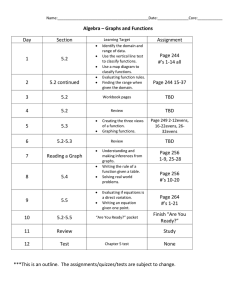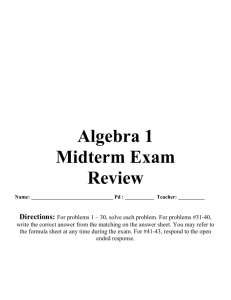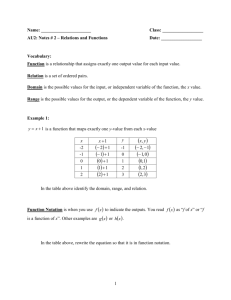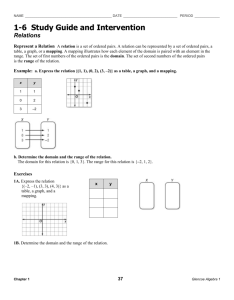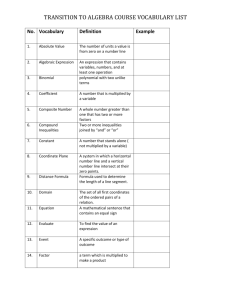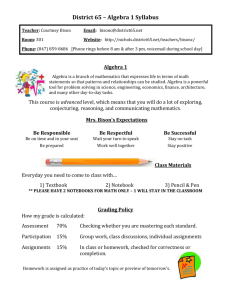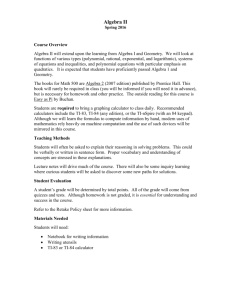Chapter 5 section 2
advertisement
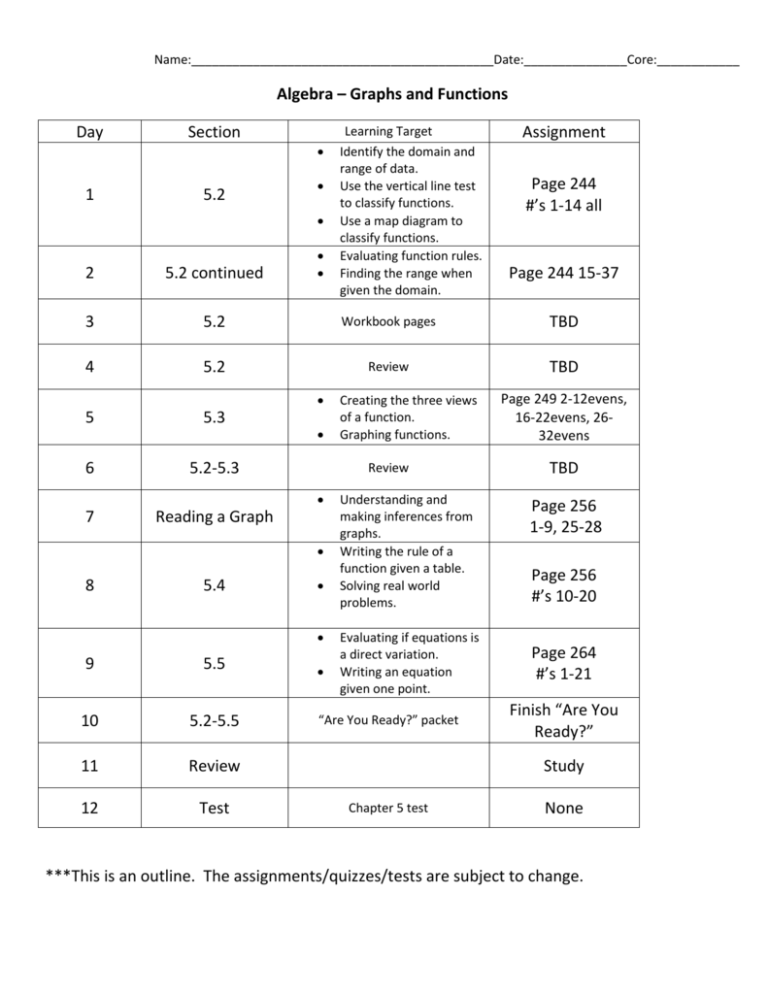
Name:____________________________________________Date:_______________Core:____________
Algebra – Graphs and Functions
Day
Section
1
5.2
Learning Target
Identify the domain and
range of data.
Use the vertical line test
to classify functions.
Use a map diagram to
classify functions.
Evaluating function rules.
Finding the range when
given the domain.
Assignment
Page 244
#’s 1-14 all
2
5.2 continued
3
5.2
Workbook pages
TBD
4
5.2
Review
TBD
5
5.3
6
5.2-5.3
Review
7
Reading a Graph
8
5.4
9
5.5
10
5.2-5.5
11
Review
12
Test
Creating the three views
of a function.
Graphing functions.
Understanding and
making inferences from
graphs.
Writing the rule of a
function given a table.
Solving real world
problems.
Evaluating if equations is
a direct variation.
Writing an equation
given one point.
“Are You Ready?” packet
Page 244 15-37
Page 249 2-12evens,
16-22evens, 2632evens
TBD
Page 256
1-9, 25-28
Page 256
#’s 10-20
Page 264
#’s 1-21
Finish “Are You
Ready?”
Study
Chapter 5 test
None
***This is an outline. The assignments/quizzes/tests are subject to change.
Algebra
Chapter 5 section 2
Day 1
Relations and Functions
Warm up
Graph each point on the coordinate plane provided:
(2, -4)
(0, 3)
(-1,-2)
(-3, 0)
Evaluate each expression:
3a – 2 for when a = -5
x + 3 for when x = 3
-6
Learning Targets: Students will be able to solve for the domain and range of ordered pairs, and determine whether
a relation is a function by using the vertical line test or through using a map diagram.
Vocabulary
Relation: is a set of _______________ _______________
Domain: of a relation is the set of _________ __________________ of the ordered pairs.
Range: of a relation is the set of _______________ coordinates of the ordered pairs.
Objective 1) How to find the domain and range of a set of ordered pairs.
Age
Height
(Years)
(meters)
18
4.25
20
4.40
21
5.25
14
5.00
18
4.85
Domain
Range
Practice: Find the domain and Range of the ordered pairs below:
{(4, 6), (6, 7), (4, 3), (5, 19), (5, 7)}
Domain
Range
Function: is a relation that assigns exactly ____________ value in the ______________ to each value in the
_______________.
Vertical-line test: If any __________________ line passes through more than ___________ point of the graph,
the relation _____________________ a function.
Objective 2) How to use the vertical line test to determine if a relation is a function.
Practice: Graph the following coordinates & determine if the relation is a function:
{(4, -2), (1, 2), (0, 1), (-2, 2)}
Objective 3) How to use a map diagram to determine if a relation is a function.
{(11, -2), (12, -1), (13, -2), (20, 7)}
{(-2, -1), (-1, 0), (6, 3), (-2, 1)}
Domain
Domain
Range
Range
Practice: Use a mapping diagram to determine whether each relation is a function:
{(3, -2), (8, 1), (9, 2), (3, 3), (-4, 0)}
Homework:
Page: 244 1-14all
Algebra
Chapter 5 section 2
Day 2
Relations and Functions (continued)
Warm up
Write the domain and range of the following relations:
{(3, 0), (-2, 1), (0, -1), (-3, 2), (3, 2)}
Determine if the following relations are functions by using the vertical-line test or a mapping diagram:
{(6.5, 0), (7, -1), (6, 2), (2, 6), (5, -1)}
{(3, 9), (-2, 9), (4, 9), (-.5, 9)}
Learning Target: Students will be able to evaluate functions using function rules and finding the range of a
function when given the domain.
Vocabulary:
Function Rule: is an ________________that describes a ________________. You can think of a function rule as
an input-output machine.
Function Notation: when you use _________ to indicate the outputs.
Objective 1) Evaluating a Function Rule
Evaluate f(n) = -3n – 10 for n = 6
Function rule
Read “f of n is
equal to ….”
Reading Math:
Evaluate -2𝑥 2 + 7 for x = -4
You can think of the
notation f(6) as
“replace n/x with 6
to find the value of
f(6).”
Practice!!
Evaluate f(x) = 𝑥 2 – 4 for x = 2.1
Objective 2) Finding range when given the domain.
Evaluate the function rule f(a) = -3a + 5 to find the range of the function for the domain {-3, 1, 4}
Practice!! Find the range of each function for the domain {-2, 0, 5}
f(x) = x – 6
Homework: Page 244 15-37
g(t) = 𝑡 2 + 1
Algebra
Chapter 5 section 3
Day 5
Warm up:
Solve the following (remember your order of operations!)
(( 9 + 5 ) +(20 ÷ 10)2) x 42
16 +( 7 +(11 − 2 )2) + 5
Learning Target: Students will be able to graph functions using a table, plotting points, and joining coordinates
to form a line.
Vocabulary:
Independent variable: Are the _____________ values and lie on the __________________.
Dependent variable: Are the _____________ values and lie on the _________________.
Objective 1) Viewing functions in three ways:
1
Model the function rule y = 2 𝑥 + 3
Step 1: Choose the input values for x. Then evaluate to find y.
X
1
y = 2𝑥 + 3
Step 2: plot points for the ordered pars.
Step 3: join the points to form a line.
(x,y)
Objective 2) graphing functions using the three methods of viewing functions
Graph the function y = |x|
Step 1: make an input/output table similar to the table we made in the previous example:
Step 2: graph the data and connect the points.
Practice!! Graph the function y = 𝑥 2 + 1
Homework: Page 249 #’s 212evens, 16-22evens, and 2632evens
Algebra
Chapter 5 section 4
Day 6
Warm up
Reading Graphs
1) What advancements have been made in aircraft technology?
2) What other flight management systems are being considered to improve flight safety?
3) Will newspapers ever put stories in context?
Learning Target: Students will be able to write a rule when given a table of data or graph.
-to create a table from a graph, identify the coordinates of the points on the graph.
x
y
-in order to write a function rule from a table, you need to _______________________________ among the data.
(ask yourself, what do I need to do to x in order to get y)
Example 2)
-What pattern do you notice?
x
y
1
5
2
6
3
7
4
8
Practice:
What is the function rule of this graph?
x
y
1
1
2
4
What is the rule when given this table?
HOMEWORK:
3
9
4
16
Page: 256 1-9, 25-28
Algebra
Chapter 5 section 4
Day 7
Warm up
Find the range of this function given the domain {-2, -1, 0, 4}
f(x) = |x| - 4
Graph g(x) = 3x - 1
Learning Target: Student will be able to write a function rule when given a written situation.
1) Suppose you borrow money from a relative to buy a lawn mower that costs $245. You charge $18 to mow a
lawn. Write a rule to describe your profit as a function of the number of lawns mowed.
2) Suppose you buy a word-processing software package for $199. You charge $15 per hour for word
processing. Write a rule to describe your profit as a function of the number of hours you work.
Practice on your own:
Write a function rule that would describe the cost in dollars of printing dollar bills when it costs $.04 to print a
dollar bill.
Write a function rule that would describe the amount of money you can earn mowing lawns at $15 per lawn.
Algebra
Chapter 5 section 5
Day 8
Warm up
Solve each equation for the given variable:
nq = m (solve for q)
d = rt (solve for r)
ax + by = 0 (solve for y)
Learning Target: Students will be able to evaluate functions and determine if they are a direct variation.
When two variables are related in such a way that the ratio of their _________________________ always
remains the ____________, the two variables are said to be in direct variation.
Compare the two functions:
f(x) = 2x
X
1
2
3
4
f(x) = 2x + 3
Y
2
4
6
8
x
1
2
3
4
Y
5
7
9
11
A function in the form of ________________ where ______________, is a direct variation.
Objective 1) is an equation a direct variation?
5x + 2y = 0
Steps to solve:
1) Solve the equation for the variable y.
2) Is the equation written in the form
y = kx where k does not = 0?
5x + 2y = 9
Practice:
Are the following equations a direct variation?
7y = 2x
3y + 4x = 8
y – 7.5x = 0
Objective 2) Write an equation of direct variation when given a point
-Write an equation of the direct variation that includes the point (4, -3)
y = kx
Steps to solve:
1) Start with the function form of direct variation.
2) Substitute 4 for x and -3 for y.
3) Solve for k. This is your constant of variation.
4) Write your equation using your constant of variation.
Write an equation of the direct variation that includes the point ( -3, -6)
Practice:
Write an equation of the direct variation that includes the point (3,5).
Write an equation of the direct variation that includes the point (5, 15).
Homework:
Page 264 #’s 1-21 all
